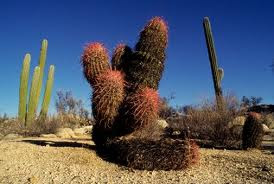This amazing plant actually suppresses your appetite for hours on end. Just what you need to help your slimming efforts. If you can control your appetite, you can control your weight. Much better than incredibly complicated calorie counting or weird, hard to stick to diets.
But it's not just any Hoodia that's effective. The real deal variety is called Hoodia Gordonii.
A leafless, spiny and succulent plant that grows naturally in South Africa and Namibia. The indigenous Sans tribe call it hoba. It takes about five years until Hoodia Gordonii's pale purple flowers grow, which is a sign that the plant can be harvested.
Although there are over 13 types of Hoodia, only Hoodia Gordonii is thought to contain a steroidal glycoside called p57, which is the only active ingredient identified so far.
Brief history of Hoodia Gordonii
Back in 1937, a Dutch anthropologist was studying the San Bushmen of the Kalahari and observed them using Hoodia Gordonii to suppress their appetite. Then in 1963, scientists at the Council for Scientific and Industrial Research (CSIR), South Africa's national laboratory, took interest and began studying Hoodia.
They found that lab animals lost weight after they were given Hoodia Gordonii.
The South African scientists worked alongside Phytopharm, a British company and isolated an active ingredient in Hoodia Gordonii, which they named p57. After a patent was obtained in 1995 they licensed p57 to Phytopharm, who had spent over $20 million on hoodia research.
Then Pfizer the pharmaceutical giant learned about Hoodia and expressed interest in developing a hoodia drug and in 1998, Phytopharm sub-licensed the p57 development rights to Pfizer for $21 million and Pfizer returned the rights to Hoodia to Phytopharm, who is now working with Unilever.
The big story on Hoodia Gordonii began after 60 Minutes correspondent Leslie Stahl and her camera crew went to Africa to try Hoodia. After a local Bushman lead them into the desert to find some hoodia, Stahl ate it. She reported that she lost the desire to eat or drink for the whole day, and also said she didn't feel any side effects, like indigestion or heart palpitations.
And famously, after trying Hoodia for himself, the BBC Correspondent Tom Mangold, reporting from the Kalahari said, "We did not even think about food. Our brains really were telling us we were full. It was a magnificent deception."
This is serious stuff. Hoodia Gordonii can supress your appetite for hours without side effects. When you hear respected journalists of this calibre reporting their positive experiences it's good news. And when you see big companies like Pfizer and Unilever showing an interest, you need to pay attention. They don't invest millions without solid research.
Hoodia patches: the best source of appetite destroying Hoodia
If you want to experience the amazing weight loss effects of Hoodia Gordonii, there is now a great new product. Hoodia Patches combine the power of Hoodia with transdermal technology.
Basically you stick a Hoodia patch on your skin for the day and it soaks through your skin and straight into your bloodstream, to effectively control your appetite and help the pounds fall off. No worrying about wasting most of it through digestion as you do with pills.
Click here to read more about the amazing mix of Hoodia Gordonii and transdermal technology, and how it can help you lose huge amounts of weight.
Related Posts :
Does Hoodia Work : 31.08.2010
Hoodia Patch : 15.08.2010
Hoodia Weight Loss Patch : 30.07.2010

No comments:
Post a Comment